Research Project: CRM, Brand Equity, and Customer Loyalty
VerifiedAdded on 2022/10/10
|12
|2682
|149
Project
AI Summary
This research project examines the crucial role of Customer Relationship Management (CRM) in building brand equity and fostering customer loyalty. The project begins with a comprehensive literature review exploring the existing research on CRM's impact on brand equity, brand loyalty, and customer relationships. It then outlines the research aim, which is to investigate the relationship between CRM, brand equity, and customer loyalty, followed by the research question: Does CRM system helps in building brand equity and promoting brand loyalty?. The research plan details the methodology, including the use of secondary data collection and qualitative data analysis. A Gantt chart provides a timeline for the project, outlining the stages from initiation to submission. The project highlights the importance of CRM in gathering customer data, building brand recognition, and implementing customer loyalty programs. The research emphasizes the significance of customer involvement, data analysis, and rewarding loyal customers in enhancing brand equity and driving customer loyalty. The project concludes with a discussion of the findings, challenges, and ethical considerations in the context of CRM's influence on brand equity and loyalty.
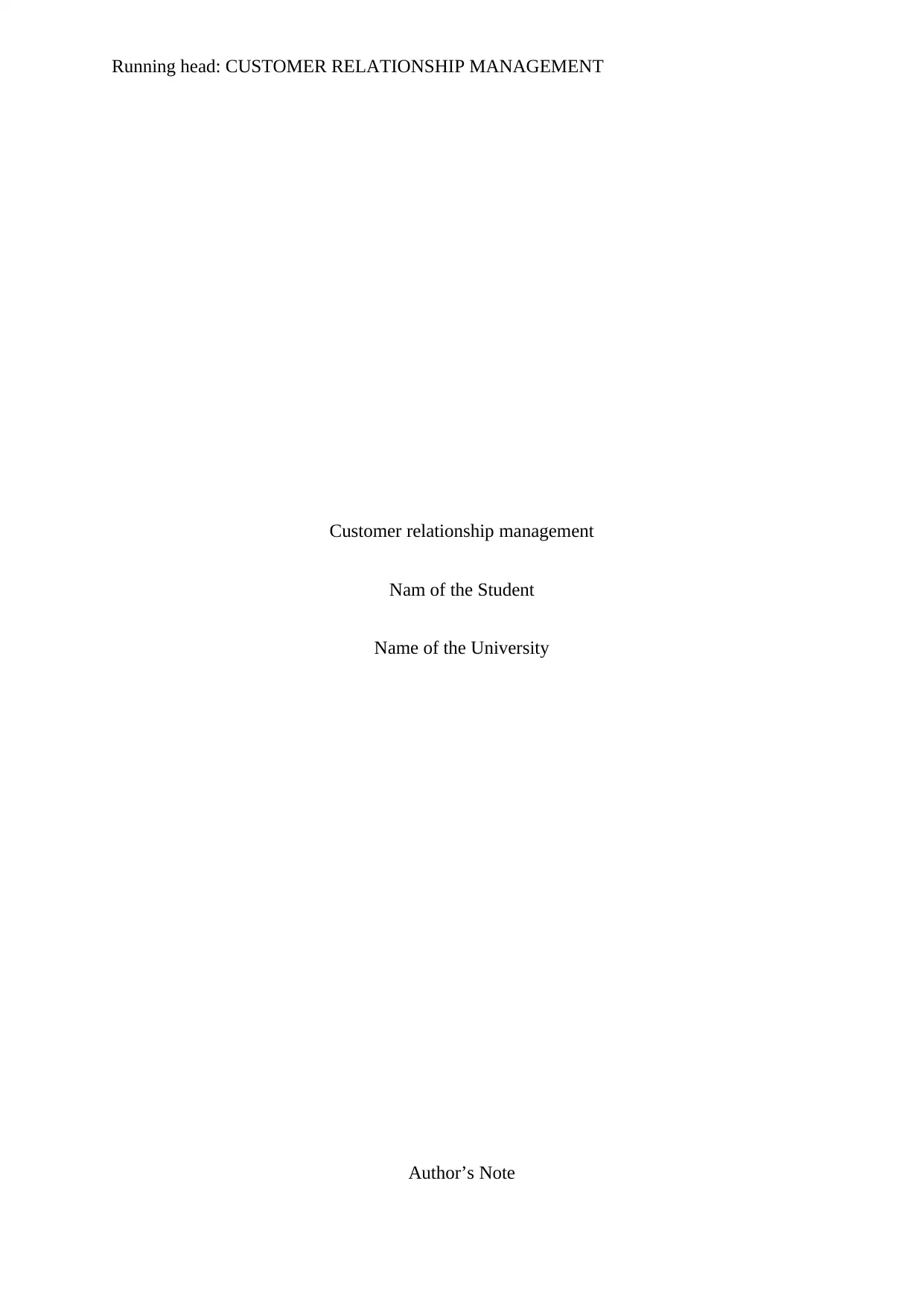
Running head: CUSTOMER RELATIONSHIP MANAGEMENT
Customer relationship management
Nam of the Student
Name of the University
Author’s Note
Customer relationship management
Nam of the Student
Name of the University
Author’s Note
Paraphrase This Document
Need a fresh take? Get an instant paraphrase of this document with our AI Paraphraser
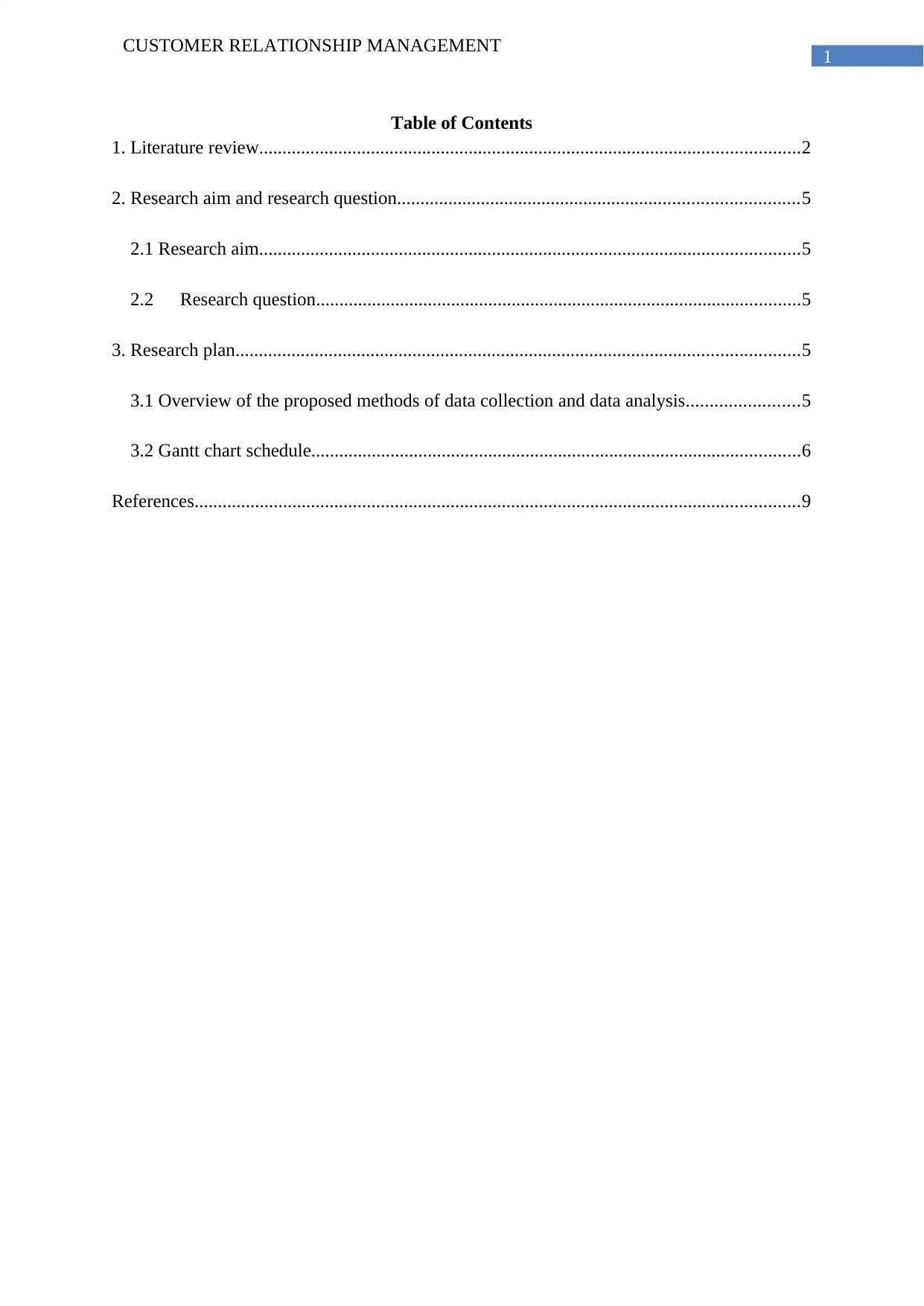
1
CUSTOMER RELATIONSHIP MANAGEMENT
Table of Contents
1. Literature review....................................................................................................................2
2. Research aim and research question......................................................................................5
2.1 Research aim....................................................................................................................5
2.2 Research question........................................................................................................5
3. Research plan.........................................................................................................................5
3.1 Overview of the proposed methods of data collection and data analysis........................5
3.2 Gantt chart schedule.........................................................................................................6
References..................................................................................................................................9
CUSTOMER RELATIONSHIP MANAGEMENT
Table of Contents
1. Literature review....................................................................................................................2
2. Research aim and research question......................................................................................5
2.1 Research aim....................................................................................................................5
2.2 Research question........................................................................................................5
3. Research plan.........................................................................................................................5
3.1 Overview of the proposed methods of data collection and data analysis........................5
3.2 Gantt chart schedule.........................................................................................................6
References..................................................................................................................................9
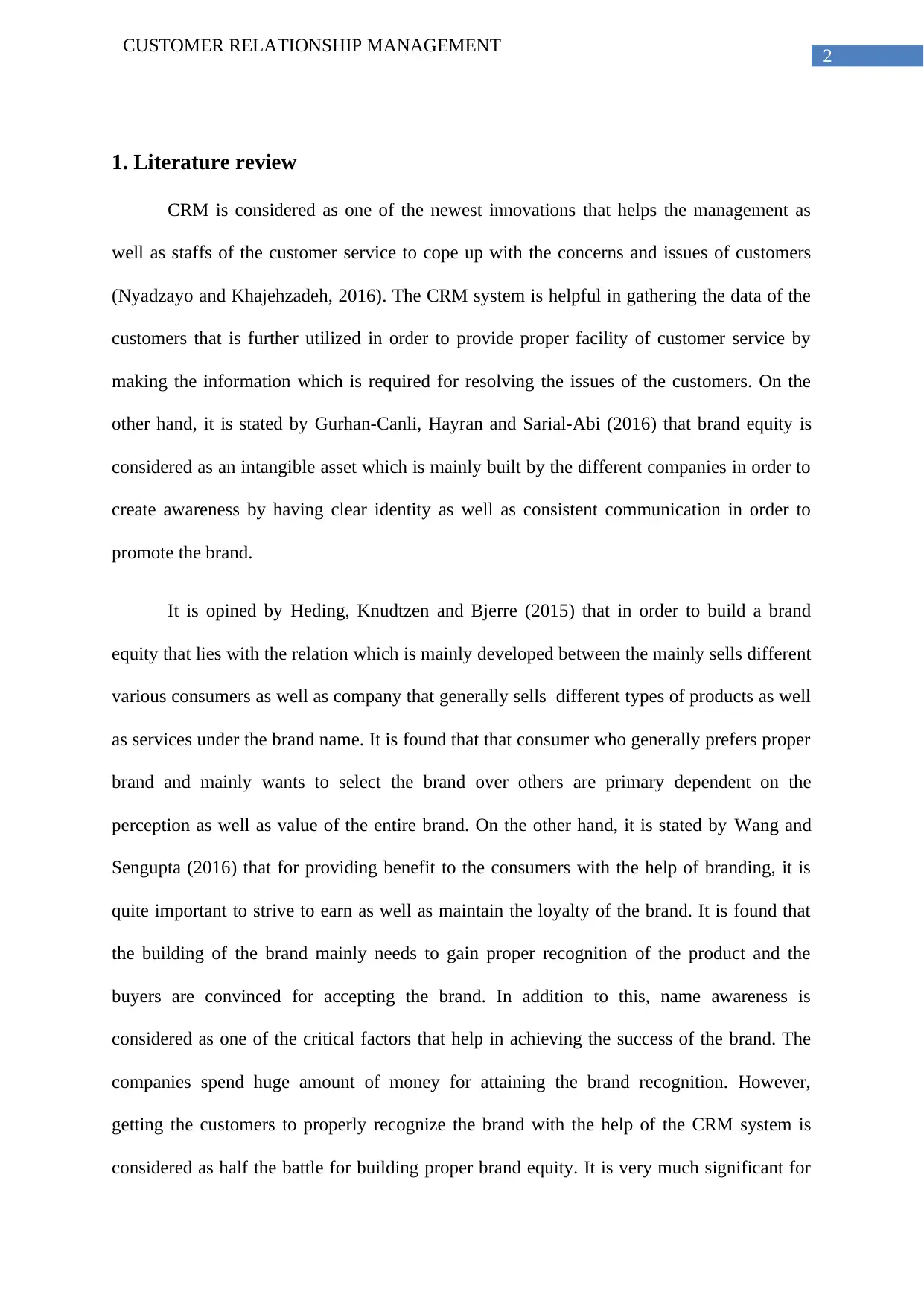
2
CUSTOMER RELATIONSHIP MANAGEMENT
1. Literature review
CRM is considered as one of the newest innovations that helps the management as
well as staffs of the customer service to cope up with the concerns and issues of customers
(Nyadzayo and Khajehzadeh, 2016). The CRM system is helpful in gathering the data of the
customers that is further utilized in order to provide proper facility of customer service by
making the information which is required for resolving the issues of the customers. On the
other hand, it is stated by Gurhan-Canli, Hayran and Sarial-Abi (2016) that brand equity is
considered as an intangible asset which is mainly built by the different companies in order to
create awareness by having clear identity as well as consistent communication in order to
promote the brand.
It is opined by Heding, Knudtzen and Bjerre (2015) that in order to build a brand
equity that lies with the relation which is mainly developed between the mainly sells different
various consumers as well as company that generally sells different types of products as well
as services under the brand name. It is found that that consumer who generally prefers proper
brand and mainly wants to select the brand over others are primary dependent on the
perception as well as value of the entire brand. On the other hand, it is stated by Wang and
Sengupta (2016) that for providing benefit to the consumers with the help of branding, it is
quite important to strive to earn as well as maintain the loyalty of the brand. It is found that
the building of the brand mainly needs to gain proper recognition of the product and the
buyers are convinced for accepting the brand. In addition to this, name awareness is
considered as one of the critical factors that help in achieving the success of the brand. The
companies spend huge amount of money for attaining the brand recognition. However,
getting the customers to properly recognize the brand with the help of the CRM system is
considered as half the battle for building proper brand equity. It is very much significant for
CUSTOMER RELATIONSHIP MANAGEMENT
1. Literature review
CRM is considered as one of the newest innovations that helps the management as
well as staffs of the customer service to cope up with the concerns and issues of customers
(Nyadzayo and Khajehzadeh, 2016). The CRM system is helpful in gathering the data of the
customers that is further utilized in order to provide proper facility of customer service by
making the information which is required for resolving the issues of the customers. On the
other hand, it is stated by Gurhan-Canli, Hayran and Sarial-Abi (2016) that brand equity is
considered as an intangible asset which is mainly built by the different companies in order to
create awareness by having clear identity as well as consistent communication in order to
promote the brand.
It is opined by Heding, Knudtzen and Bjerre (2015) that in order to build a brand
equity that lies with the relation which is mainly developed between the mainly sells different
various consumers as well as company that generally sells different types of products as well
as services under the brand name. It is found that that consumer who generally prefers proper
brand and mainly wants to select the brand over others are primary dependent on the
perception as well as value of the entire brand. On the other hand, it is stated by Wang and
Sengupta (2016) that for providing benefit to the consumers with the help of branding, it is
quite important to strive to earn as well as maintain the loyalty of the brand. It is found that
the building of the brand mainly needs to gain proper recognition of the product and the
buyers are convinced for accepting the brand. In addition to this, name awareness is
considered as one of the critical factors that help in achieving the success of the brand. The
companies spend huge amount of money for attaining the brand recognition. However,
getting the customers to properly recognize the brand with the help of the CRM system is
considered as half the battle for building proper brand equity. It is very much significant for
⊘ This is a preview!⊘
Do you want full access?
Subscribe today to unlock all pages.

Trusted by 1+ million students worldwide
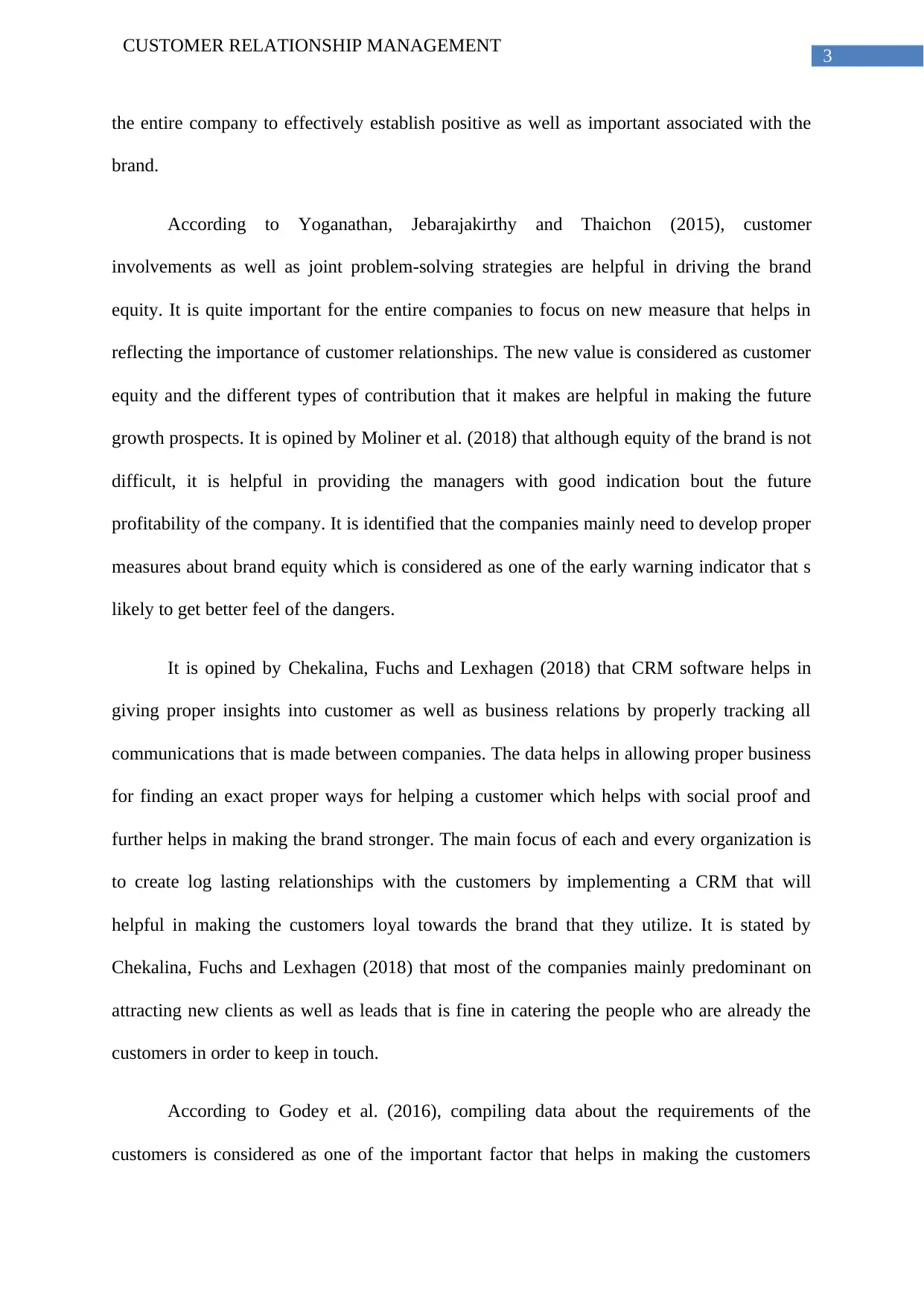
3
CUSTOMER RELATIONSHIP MANAGEMENT
the entire company to effectively establish positive as well as important associated with the
brand.
According to Yoganathan, Jebarajakirthy and Thaichon (2015), customer
involvements as well as joint problem-solving strategies are helpful in driving the brand
equity. It is quite important for the entire companies to focus on new measure that helps in
reflecting the importance of customer relationships. The new value is considered as customer
equity and the different types of contribution that it makes are helpful in making the future
growth prospects. It is opined by Moliner et al. (2018) that although equity of the brand is not
difficult, it is helpful in providing the managers with good indication bout the future
profitability of the company. It is identified that the companies mainly need to develop proper
measures about brand equity which is considered as one of the early warning indicator that s
likely to get better feel of the dangers.
It is opined by Chekalina, Fuchs and Lexhagen (2018) that CRM software helps in
giving proper insights into customer as well as business relations by properly tracking all
communications that is made between companies. The data helps in allowing proper business
for finding an exact proper ways for helping a customer which helps with social proof and
further helps in making the brand stronger. The main focus of each and every organization is
to create log lasting relationships with the customers by implementing a CRM that will
helpful in making the customers loyal towards the brand that they utilize. It is stated by
Chekalina, Fuchs and Lexhagen (2018) that most of the companies mainly predominant on
attracting new clients as well as leads that is fine in catering the people who are already the
customers in order to keep in touch.
According to Godey et al. (2016), compiling data about the requirements of the
customers is considered as one of the important factor that helps in making the customers
CUSTOMER RELATIONSHIP MANAGEMENT
the entire company to effectively establish positive as well as important associated with the
brand.
According to Yoganathan, Jebarajakirthy and Thaichon (2015), customer
involvements as well as joint problem-solving strategies are helpful in driving the brand
equity. It is quite important for the entire companies to focus on new measure that helps in
reflecting the importance of customer relationships. The new value is considered as customer
equity and the different types of contribution that it makes are helpful in making the future
growth prospects. It is opined by Moliner et al. (2018) that although equity of the brand is not
difficult, it is helpful in providing the managers with good indication bout the future
profitability of the company. It is identified that the companies mainly need to develop proper
measures about brand equity which is considered as one of the early warning indicator that s
likely to get better feel of the dangers.
It is opined by Chekalina, Fuchs and Lexhagen (2018) that CRM software helps in
giving proper insights into customer as well as business relations by properly tracking all
communications that is made between companies. The data helps in allowing proper business
for finding an exact proper ways for helping a customer which helps with social proof and
further helps in making the brand stronger. The main focus of each and every organization is
to create log lasting relationships with the customers by implementing a CRM that will
helpful in making the customers loyal towards the brand that they utilize. It is stated by
Chekalina, Fuchs and Lexhagen (2018) that most of the companies mainly predominant on
attracting new clients as well as leads that is fine in catering the people who are already the
customers in order to keep in touch.
According to Godey et al. (2016), compiling data about the requirements of the
customers is considered as one of the important factor that helps in making the customers
Paraphrase This Document
Need a fresh take? Get an instant paraphrase of this document with our AI Paraphraser
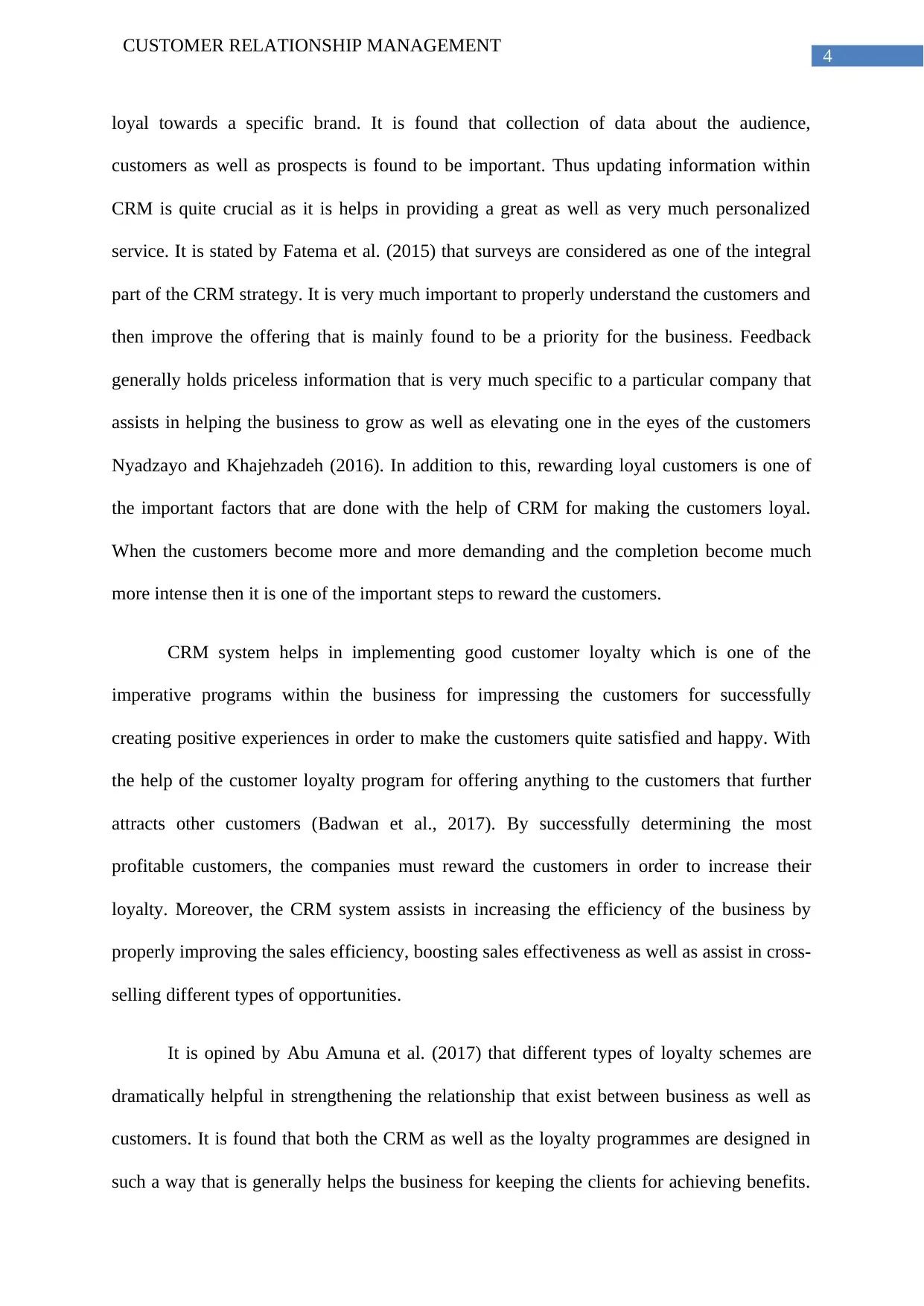
4
CUSTOMER RELATIONSHIP MANAGEMENT
loyal towards a specific brand. It is found that collection of data about the audience,
customers as well as prospects is found to be important. Thus updating information within
CRM is quite crucial as it is helps in providing a great as well as very much personalized
service. It is stated by Fatema et al. (2015) that surveys are considered as one of the integral
part of the CRM strategy. It is very much important to properly understand the customers and
then improve the offering that is mainly found to be a priority for the business. Feedback
generally holds priceless information that is very much specific to a particular company that
assists in helping the business to grow as well as elevating one in the eyes of the customers
Nyadzayo and Khajehzadeh (2016). In addition to this, rewarding loyal customers is one of
the important factors that are done with the help of CRM for making the customers loyal.
When the customers become more and more demanding and the completion become much
more intense then it is one of the important steps to reward the customers.
CRM system helps in implementing good customer loyalty which is one of the
imperative programs within the business for impressing the customers for successfully
creating positive experiences in order to make the customers quite satisfied and happy. With
the help of the customer loyalty program for offering anything to the customers that further
attracts other customers (Badwan et al., 2017). By successfully determining the most
profitable customers, the companies must reward the customers in order to increase their
loyalty. Moreover, the CRM system assists in increasing the efficiency of the business by
properly improving the sales efficiency, boosting sales effectiveness as well as assist in cross-
selling different types of opportunities.
It is opined by Abu Amuna et al. (2017) that different types of loyalty schemes are
dramatically helpful in strengthening the relationship that exist between business as well as
customers. It is found that both the CRM as well as the loyalty programmes are designed in
such a way that is generally helps the business for keeping the clients for achieving benefits.
CUSTOMER RELATIONSHIP MANAGEMENT
loyal towards a specific brand. It is found that collection of data about the audience,
customers as well as prospects is found to be important. Thus updating information within
CRM is quite crucial as it is helps in providing a great as well as very much personalized
service. It is stated by Fatema et al. (2015) that surveys are considered as one of the integral
part of the CRM strategy. It is very much important to properly understand the customers and
then improve the offering that is mainly found to be a priority for the business. Feedback
generally holds priceless information that is very much specific to a particular company that
assists in helping the business to grow as well as elevating one in the eyes of the customers
Nyadzayo and Khajehzadeh (2016). In addition to this, rewarding loyal customers is one of
the important factors that are done with the help of CRM for making the customers loyal.
When the customers become more and more demanding and the completion become much
more intense then it is one of the important steps to reward the customers.
CRM system helps in implementing good customer loyalty which is one of the
imperative programs within the business for impressing the customers for successfully
creating positive experiences in order to make the customers quite satisfied and happy. With
the help of the customer loyalty program for offering anything to the customers that further
attracts other customers (Badwan et al., 2017). By successfully determining the most
profitable customers, the companies must reward the customers in order to increase their
loyalty. Moreover, the CRM system assists in increasing the efficiency of the business by
properly improving the sales efficiency, boosting sales effectiveness as well as assist in cross-
selling different types of opportunities.
It is opined by Abu Amuna et al. (2017) that different types of loyalty schemes are
dramatically helpful in strengthening the relationship that exist between business as well as
customers. It is found that both the CRM as well as the loyalty programmes are designed in
such a way that is generally helps the business for keeping the clients for achieving benefits.
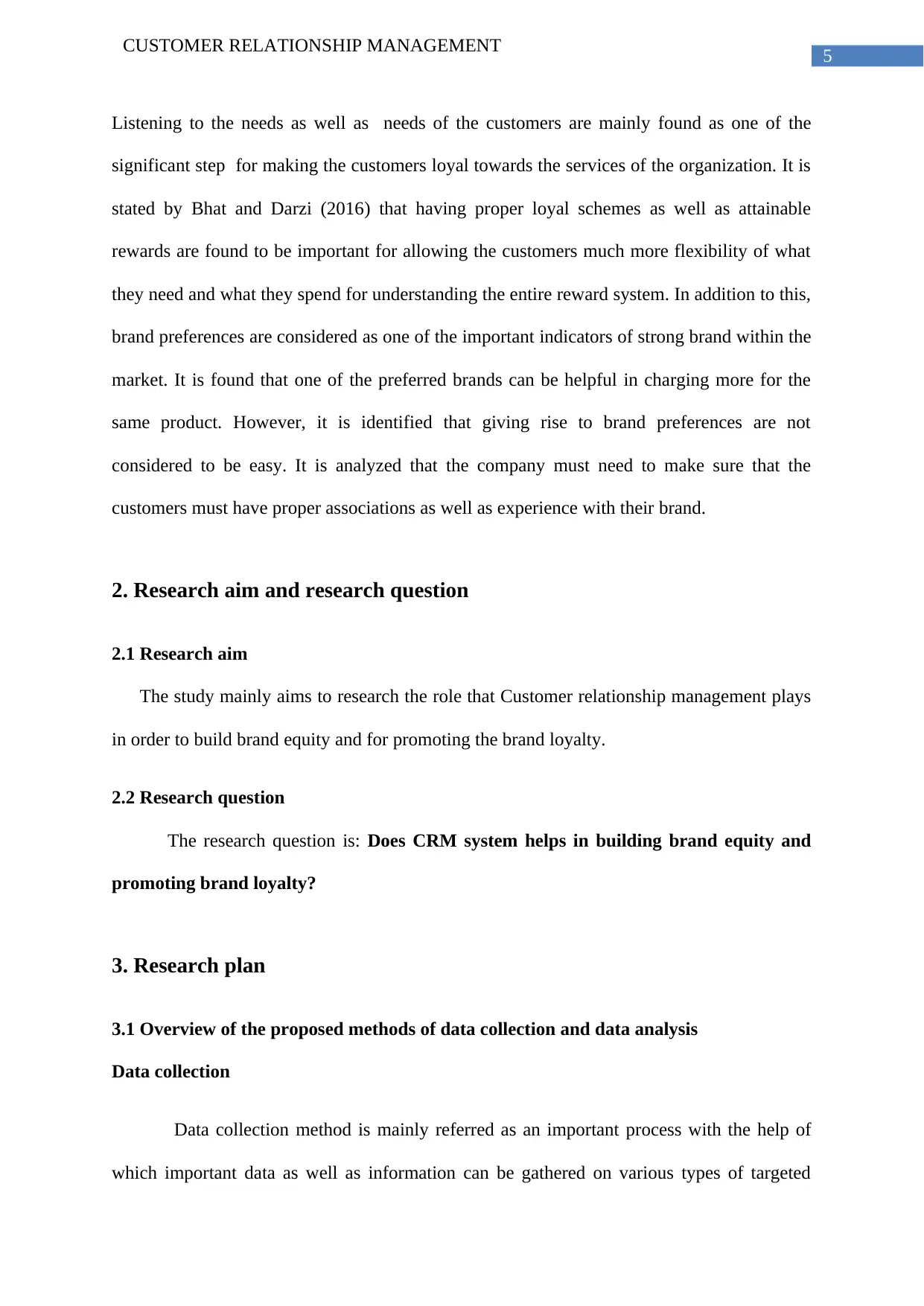
5
CUSTOMER RELATIONSHIP MANAGEMENT
Listening to the needs as well as needs of the customers are mainly found as one of the
significant step for making the customers loyal towards the services of the organization. It is
stated by Bhat and Darzi (2016) that having proper loyal schemes as well as attainable
rewards are found to be important for allowing the customers much more flexibility of what
they need and what they spend for understanding the entire reward system. In addition to this,
brand preferences are considered as one of the important indicators of strong brand within the
market. It is found that one of the preferred brands can be helpful in charging more for the
same product. However, it is identified that giving rise to brand preferences are not
considered to be easy. It is analyzed that the company must need to make sure that the
customers must have proper associations as well as experience with their brand.
2. Research aim and research question
2.1 Research aim
The study mainly aims to research the role that Customer relationship management plays
in order to build brand equity and for promoting the brand loyalty.
2.2 Research question
The research question is: Does CRM system helps in building brand equity and
promoting brand loyalty?
3. Research plan
3.1 Overview of the proposed methods of data collection and data analysis
Data collection
Data collection method is mainly referred as an important process with the help of
which important data as well as information can be gathered on various types of targeted
CUSTOMER RELATIONSHIP MANAGEMENT
Listening to the needs as well as needs of the customers are mainly found as one of the
significant step for making the customers loyal towards the services of the organization. It is
stated by Bhat and Darzi (2016) that having proper loyal schemes as well as attainable
rewards are found to be important for allowing the customers much more flexibility of what
they need and what they spend for understanding the entire reward system. In addition to this,
brand preferences are considered as one of the important indicators of strong brand within the
market. It is found that one of the preferred brands can be helpful in charging more for the
same product. However, it is identified that giving rise to brand preferences are not
considered to be easy. It is analyzed that the company must need to make sure that the
customers must have proper associations as well as experience with their brand.
2. Research aim and research question
2.1 Research aim
The study mainly aims to research the role that Customer relationship management plays
in order to build brand equity and for promoting the brand loyalty.
2.2 Research question
The research question is: Does CRM system helps in building brand equity and
promoting brand loyalty?
3. Research plan
3.1 Overview of the proposed methods of data collection and data analysis
Data collection
Data collection method is mainly referred as an important process with the help of
which important data as well as information can be gathered on various types of targeted
⊘ This is a preview!⊘
Do you want full access?
Subscribe today to unlock all pages.

Trusted by 1+ million students worldwide
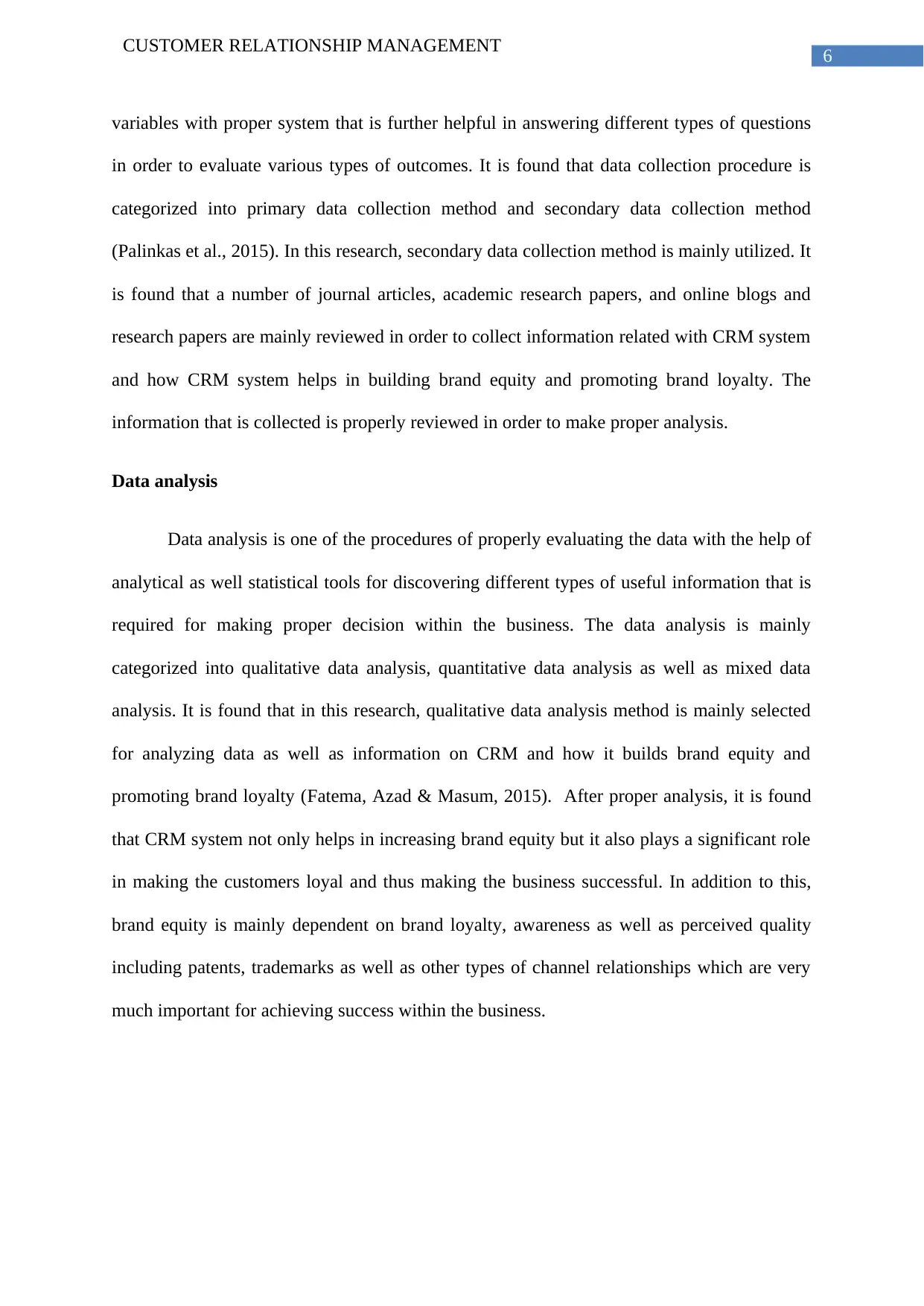
6
CUSTOMER RELATIONSHIP MANAGEMENT
variables with proper system that is further helpful in answering different types of questions
in order to evaluate various types of outcomes. It is found that data collection procedure is
categorized into primary data collection method and secondary data collection method
(Palinkas et al., 2015). In this research, secondary data collection method is mainly utilized. It
is found that a number of journal articles, academic research papers, and online blogs and
research papers are mainly reviewed in order to collect information related with CRM system
and how CRM system helps in building brand equity and promoting brand loyalty. The
information that is collected is properly reviewed in order to make proper analysis.
Data analysis
Data analysis is one of the procedures of properly evaluating the data with the help of
analytical as well statistical tools for discovering different types of useful information that is
required for making proper decision within the business. The data analysis is mainly
categorized into qualitative data analysis, quantitative data analysis as well as mixed data
analysis. It is found that in this research, qualitative data analysis method is mainly selected
for analyzing data as well as information on CRM and how it builds brand equity and
promoting brand loyalty (Fatema, Azad & Masum, 2015). After proper analysis, it is found
that CRM system not only helps in increasing brand equity but it also plays a significant role
in making the customers loyal and thus making the business successful. In addition to this,
brand equity is mainly dependent on brand loyalty, awareness as well as perceived quality
including patents, trademarks as well as other types of channel relationships which are very
much important for achieving success within the business.
CUSTOMER RELATIONSHIP MANAGEMENT
variables with proper system that is further helpful in answering different types of questions
in order to evaluate various types of outcomes. It is found that data collection procedure is
categorized into primary data collection method and secondary data collection method
(Palinkas et al., 2015). In this research, secondary data collection method is mainly utilized. It
is found that a number of journal articles, academic research papers, and online blogs and
research papers are mainly reviewed in order to collect information related with CRM system
and how CRM system helps in building brand equity and promoting brand loyalty. The
information that is collected is properly reviewed in order to make proper analysis.
Data analysis
Data analysis is one of the procedures of properly evaluating the data with the help of
analytical as well statistical tools for discovering different types of useful information that is
required for making proper decision within the business. The data analysis is mainly
categorized into qualitative data analysis, quantitative data analysis as well as mixed data
analysis. It is found that in this research, qualitative data analysis method is mainly selected
for analyzing data as well as information on CRM and how it builds brand equity and
promoting brand loyalty (Fatema, Azad & Masum, 2015). After proper analysis, it is found
that CRM system not only helps in increasing brand equity but it also plays a significant role
in making the customers loyal and thus making the business successful. In addition to this,
brand equity is mainly dependent on brand loyalty, awareness as well as perceived quality
including patents, trademarks as well as other types of channel relationships which are very
much important for achieving success within the business.
Paraphrase This Document
Need a fresh take? Get an instant paraphrase of this document with our AI Paraphraser
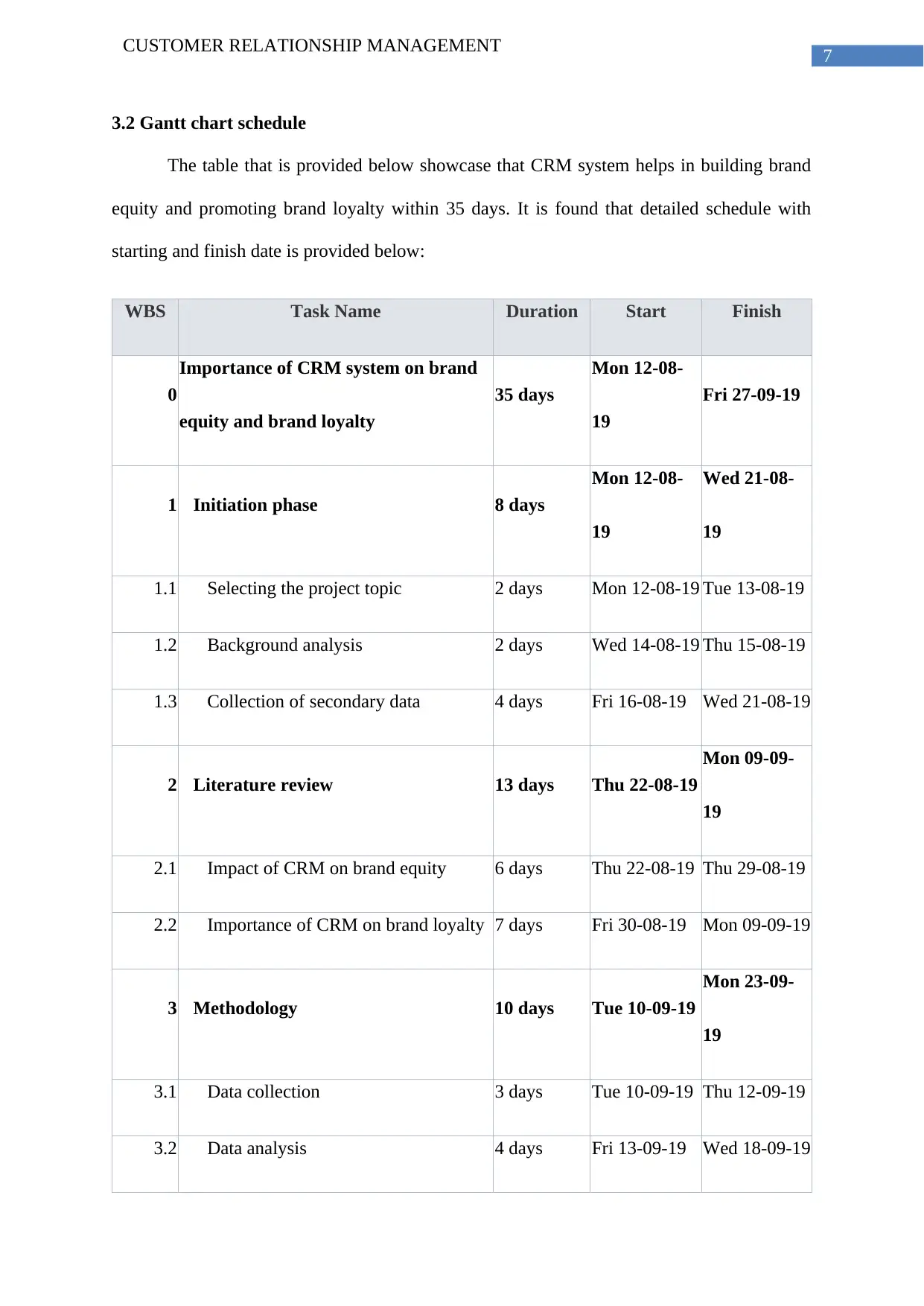
7
CUSTOMER RELATIONSHIP MANAGEMENT
3.2 Gantt chart schedule
The table that is provided below showcase that CRM system helps in building brand
equity and promoting brand loyalty within 35 days. It is found that detailed schedule with
starting and finish date is provided below:
WBS Task Name Duration Start Finish
0
Importance of CRM system on brand
equity and brand loyalty
35 days
Mon 12-08-
19
Fri 27-09-19
1 Initiation phase 8 days
Mon 12-08-
19
Wed 21-08-
19
1.1 Selecting the project topic 2 days Mon 12-08-19 Tue 13-08-19
1.2 Background analysis 2 days Wed 14-08-19 Thu 15-08-19
1.3 Collection of secondary data 4 days Fri 16-08-19 Wed 21-08-19
2 Literature review 13 days Thu 22-08-19
Mon 09-09-
19
2.1 Impact of CRM on brand equity 6 days Thu 22-08-19 Thu 29-08-19
2.2 Importance of CRM on brand loyalty 7 days Fri 30-08-19 Mon 09-09-19
3 Methodology 10 days Tue 10-09-19
Mon 23-09-
19
3.1 Data collection 3 days Tue 10-09-19 Thu 12-09-19
3.2 Data analysis 4 days Fri 13-09-19 Wed 18-09-19
CUSTOMER RELATIONSHIP MANAGEMENT
3.2 Gantt chart schedule
The table that is provided below showcase that CRM system helps in building brand
equity and promoting brand loyalty within 35 days. It is found that detailed schedule with
starting and finish date is provided below:
WBS Task Name Duration Start Finish
0
Importance of CRM system on brand
equity and brand loyalty
35 days
Mon 12-08-
19
Fri 27-09-19
1 Initiation phase 8 days
Mon 12-08-
19
Wed 21-08-
19
1.1 Selecting the project topic 2 days Mon 12-08-19 Tue 13-08-19
1.2 Background analysis 2 days Wed 14-08-19 Thu 15-08-19
1.3 Collection of secondary data 4 days Fri 16-08-19 Wed 21-08-19
2 Literature review 13 days Thu 22-08-19
Mon 09-09-
19
2.1 Impact of CRM on brand equity 6 days Thu 22-08-19 Thu 29-08-19
2.2 Importance of CRM on brand loyalty 7 days Fri 30-08-19 Mon 09-09-19
3 Methodology 10 days Tue 10-09-19
Mon 23-09-
19
3.1 Data collection 3 days Tue 10-09-19 Thu 12-09-19
3.2 Data analysis 4 days Fri 13-09-19 Wed 18-09-19
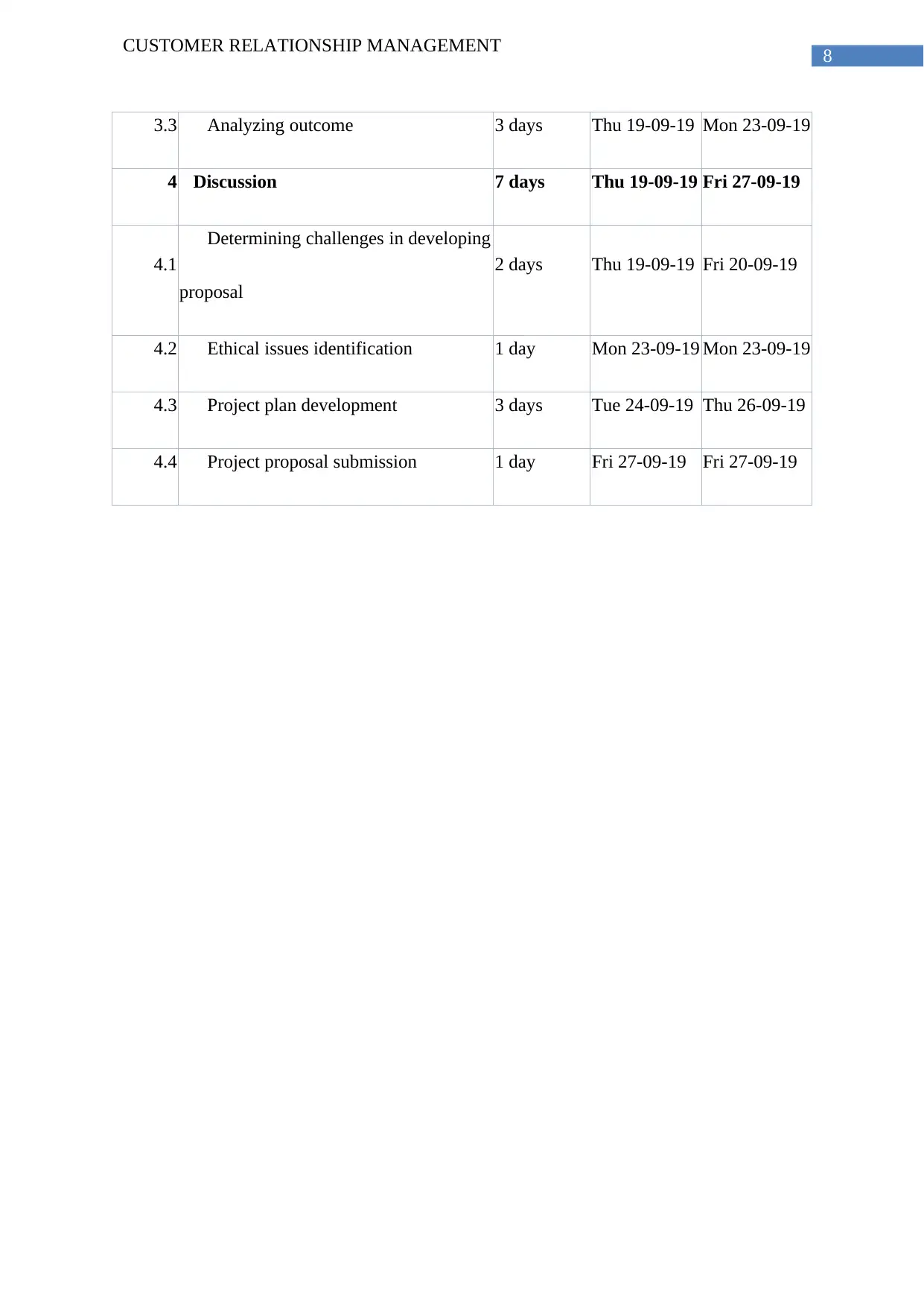
8
CUSTOMER RELATIONSHIP MANAGEMENT
3.3 Analyzing outcome 3 days Thu 19-09-19 Mon 23-09-19
4 Discussion 7 days Thu 19-09-19 Fri 27-09-19
4.1
Determining challenges in developing
proposal
2 days Thu 19-09-19 Fri 20-09-19
4.2 Ethical issues identification 1 day Mon 23-09-19 Mon 23-09-19
4.3 Project plan development 3 days Tue 24-09-19 Thu 26-09-19
4.4 Project proposal submission 1 day Fri 27-09-19 Fri 27-09-19
CUSTOMER RELATIONSHIP MANAGEMENT
3.3 Analyzing outcome 3 days Thu 19-09-19 Mon 23-09-19
4 Discussion 7 days Thu 19-09-19 Fri 27-09-19
4.1
Determining challenges in developing
proposal
2 days Thu 19-09-19 Fri 20-09-19
4.2 Ethical issues identification 1 day Mon 23-09-19 Mon 23-09-19
4.3 Project plan development 3 days Tue 24-09-19 Thu 26-09-19
4.4 Project proposal submission 1 day Fri 27-09-19 Fri 27-09-19
⊘ This is a preview!⊘
Do you want full access?
Subscribe today to unlock all pages.

Trusted by 1+ million students worldwide
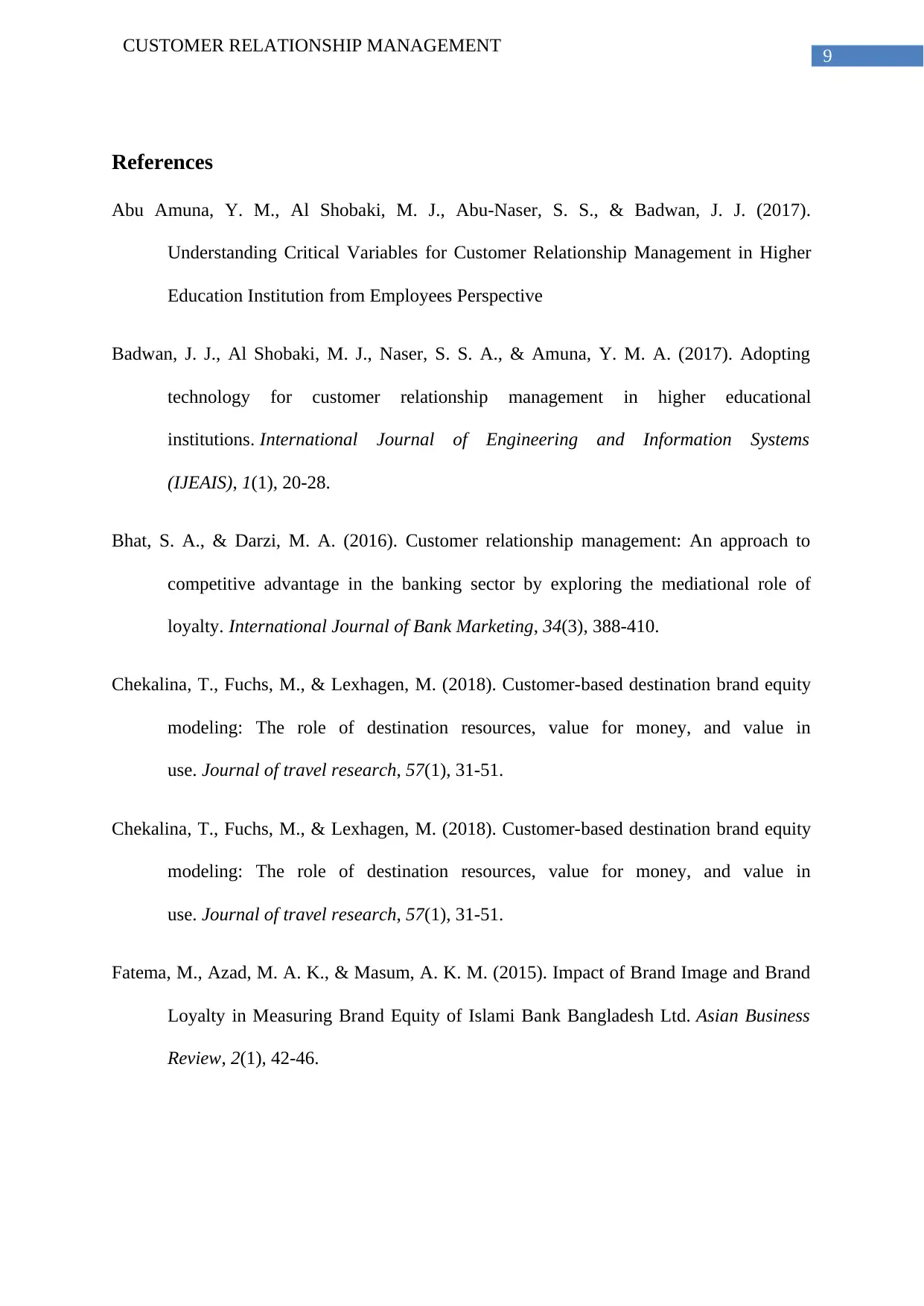
9
CUSTOMER RELATIONSHIP MANAGEMENT
References
Abu Amuna, Y. M., Al Shobaki, M. J., Abu-Naser, S. S., & Badwan, J. J. (2017).
Understanding Critical Variables for Customer Relationship Management in Higher
Education Institution from Employees Perspective
Badwan, J. J., Al Shobaki, M. J., Naser, S. S. A., & Amuna, Y. M. A. (2017). Adopting
technology for customer relationship management in higher educational
institutions. International Journal of Engineering and Information Systems
(IJEAIS), 1(1), 20-28.
Bhat, S. A., & Darzi, M. A. (2016). Customer relationship management: An approach to
competitive advantage in the banking sector by exploring the mediational role of
loyalty. International Journal of Bank Marketing, 34(3), 388-410.
Chekalina, T., Fuchs, M., & Lexhagen, M. (2018). Customer-based destination brand equity
modeling: The role of destination resources, value for money, and value in
use. Journal of travel research, 57(1), 31-51.
Chekalina, T., Fuchs, M., & Lexhagen, M. (2018). Customer-based destination brand equity
modeling: The role of destination resources, value for money, and value in
use. Journal of travel research, 57(1), 31-51.
Fatema, M., Azad, M. A. K., & Masum, A. K. M. (2015). Impact of Brand Image and Brand
Loyalty in Measuring Brand Equity of Islami Bank Bangladesh Ltd. Asian Business
Review, 2(1), 42-46.
CUSTOMER RELATIONSHIP MANAGEMENT
References
Abu Amuna, Y. M., Al Shobaki, M. J., Abu-Naser, S. S., & Badwan, J. J. (2017).
Understanding Critical Variables for Customer Relationship Management in Higher
Education Institution from Employees Perspective
Badwan, J. J., Al Shobaki, M. J., Naser, S. S. A., & Amuna, Y. M. A. (2017). Adopting
technology for customer relationship management in higher educational
institutions. International Journal of Engineering and Information Systems
(IJEAIS), 1(1), 20-28.
Bhat, S. A., & Darzi, M. A. (2016). Customer relationship management: An approach to
competitive advantage in the banking sector by exploring the mediational role of
loyalty. International Journal of Bank Marketing, 34(3), 388-410.
Chekalina, T., Fuchs, M., & Lexhagen, M. (2018). Customer-based destination brand equity
modeling: The role of destination resources, value for money, and value in
use. Journal of travel research, 57(1), 31-51.
Chekalina, T., Fuchs, M., & Lexhagen, M. (2018). Customer-based destination brand equity
modeling: The role of destination resources, value for money, and value in
use. Journal of travel research, 57(1), 31-51.
Fatema, M., Azad, M. A. K., & Masum, A. K. M. (2015). Impact of Brand Image and Brand
Loyalty in Measuring Brand Equity of Islami Bank Bangladesh Ltd. Asian Business
Review, 2(1), 42-46.
Paraphrase This Document
Need a fresh take? Get an instant paraphrase of this document with our AI Paraphraser
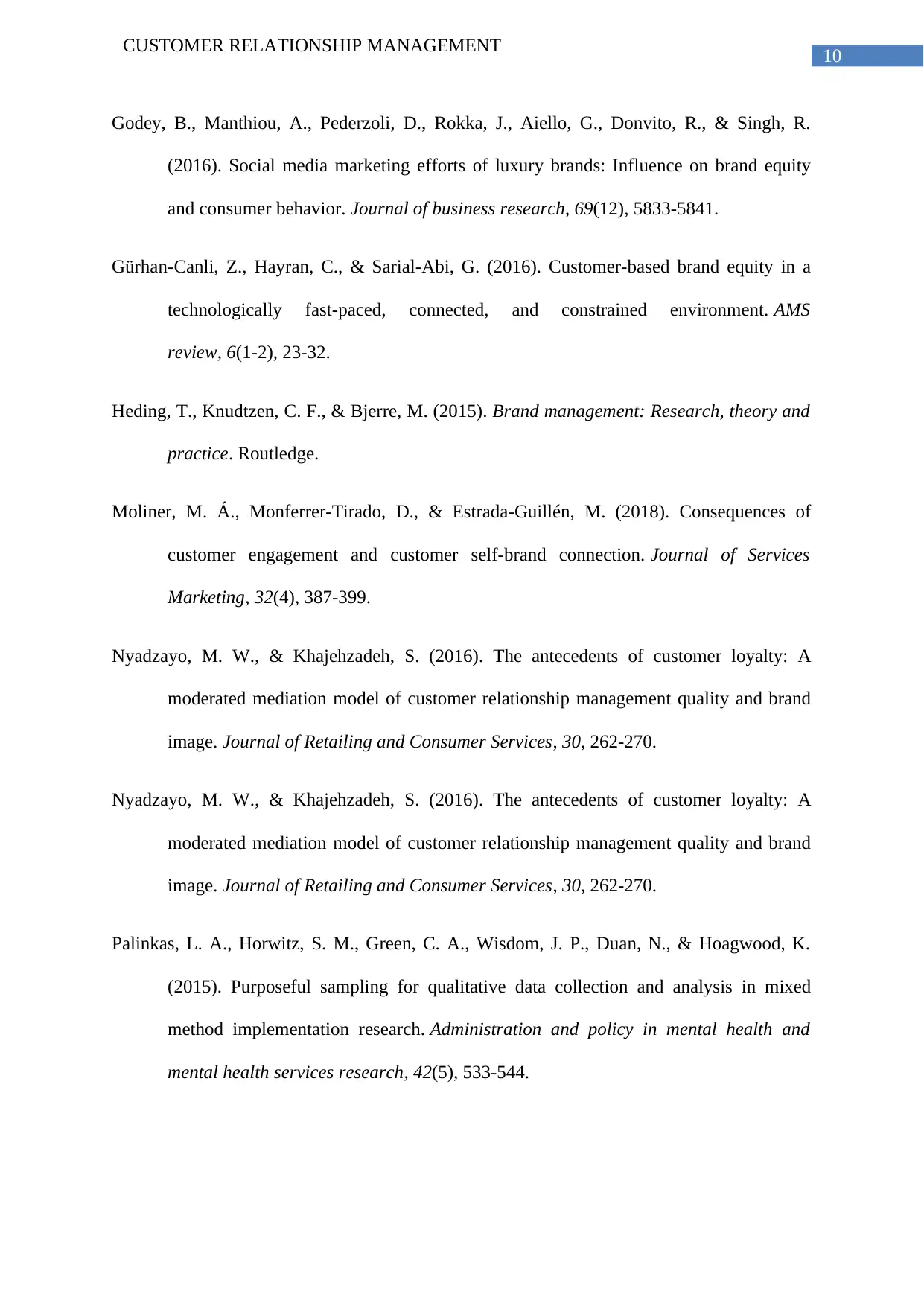
10
CUSTOMER RELATIONSHIP MANAGEMENT
Godey, B., Manthiou, A., Pederzoli, D., Rokka, J., Aiello, G., Donvito, R., & Singh, R.
(2016). Social media marketing efforts of luxury brands: Influence on brand equity
and consumer behavior. Journal of business research, 69(12), 5833-5841.
Gürhan-Canli, Z., Hayran, C., & Sarial-Abi, G. (2016). Customer-based brand equity in a
technologically fast-paced, connected, and constrained environment. AMS
review, 6(1-2), 23-32.
Heding, T., Knudtzen, C. F., & Bjerre, M. (2015). Brand management: Research, theory and
practice. Routledge.
Moliner, M. Á., Monferrer-Tirado, D., & Estrada-Guillén, M. (2018). Consequences of
customer engagement and customer self-brand connection. Journal of Services
Marketing, 32(4), 387-399.
Nyadzayo, M. W., & Khajehzadeh, S. (2016). The antecedents of customer loyalty: A
moderated mediation model of customer relationship management quality and brand
image. Journal of Retailing and Consumer Services, 30, 262-270.
Nyadzayo, M. W., & Khajehzadeh, S. (2016). The antecedents of customer loyalty: A
moderated mediation model of customer relationship management quality and brand
image. Journal of Retailing and Consumer Services, 30, 262-270.
Palinkas, L. A., Horwitz, S. M., Green, C. A., Wisdom, J. P., Duan, N., & Hoagwood, K.
(2015). Purposeful sampling for qualitative data collection and analysis in mixed
method implementation research. Administration and policy in mental health and
mental health services research, 42(5), 533-544.
CUSTOMER RELATIONSHIP MANAGEMENT
Godey, B., Manthiou, A., Pederzoli, D., Rokka, J., Aiello, G., Donvito, R., & Singh, R.
(2016). Social media marketing efforts of luxury brands: Influence on brand equity
and consumer behavior. Journal of business research, 69(12), 5833-5841.
Gürhan-Canli, Z., Hayran, C., & Sarial-Abi, G. (2016). Customer-based brand equity in a
technologically fast-paced, connected, and constrained environment. AMS
review, 6(1-2), 23-32.
Heding, T., Knudtzen, C. F., & Bjerre, M. (2015). Brand management: Research, theory and
practice. Routledge.
Moliner, M. Á., Monferrer-Tirado, D., & Estrada-Guillén, M. (2018). Consequences of
customer engagement and customer self-brand connection. Journal of Services
Marketing, 32(4), 387-399.
Nyadzayo, M. W., & Khajehzadeh, S. (2016). The antecedents of customer loyalty: A
moderated mediation model of customer relationship management quality and brand
image. Journal of Retailing and Consumer Services, 30, 262-270.
Nyadzayo, M. W., & Khajehzadeh, S. (2016). The antecedents of customer loyalty: A
moderated mediation model of customer relationship management quality and brand
image. Journal of Retailing and Consumer Services, 30, 262-270.
Palinkas, L. A., Horwitz, S. M., Green, C. A., Wisdom, J. P., Duan, N., & Hoagwood, K.
(2015). Purposeful sampling for qualitative data collection and analysis in mixed
method implementation research. Administration and policy in mental health and
mental health services research, 42(5), 533-544.
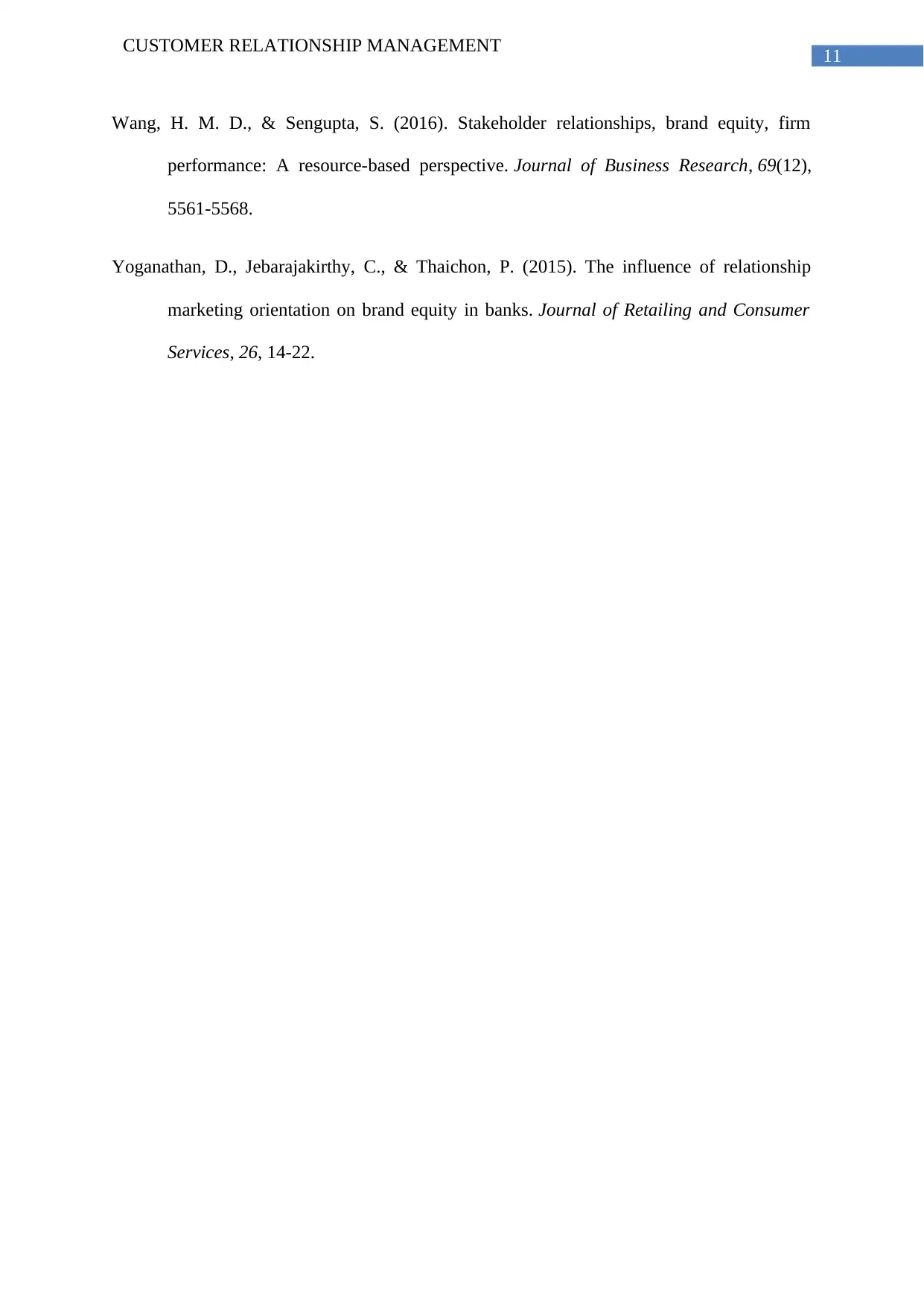
11
CUSTOMER RELATIONSHIP MANAGEMENT
Wang, H. M. D., & Sengupta, S. (2016). Stakeholder relationships, brand equity, firm
performance: A resource-based perspective. Journal of Business Research, 69(12),
5561-5568.
Yoganathan, D., Jebarajakirthy, C., & Thaichon, P. (2015). The influence of relationship
marketing orientation on brand equity in banks. Journal of Retailing and Consumer
Services, 26, 14-22.
CUSTOMER RELATIONSHIP MANAGEMENT
Wang, H. M. D., & Sengupta, S. (2016). Stakeholder relationships, brand equity, firm
performance: A resource-based perspective. Journal of Business Research, 69(12),
5561-5568.
Yoganathan, D., Jebarajakirthy, C., & Thaichon, P. (2015). The influence of relationship
marketing orientation on brand equity in banks. Journal of Retailing and Consumer
Services, 26, 14-22.
⊘ This is a preview!⊘
Do you want full access?
Subscribe today to unlock all pages.

Trusted by 1+ million students worldwide
1 out of 12
Related Documents
Your All-in-One AI-Powered Toolkit for Academic Success.
+13062052269
info@desklib.com
Available 24*7 on WhatsApp / Email
![[object Object]](/_next/static/media/star-bottom.7253800d.svg)
Unlock your academic potential
Copyright © 2020–2025 A2Z Services. All Rights Reserved. Developed and managed by ZUCOL.




